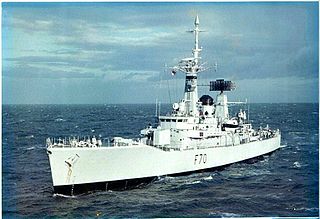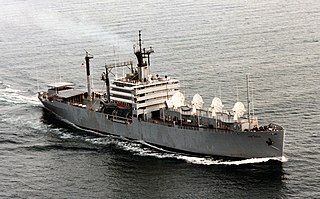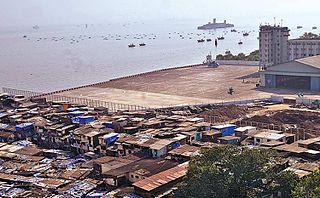
An aircraft carrier is a warship that serves as a seagoing airbase, equipped with a full-length flight deck and facilities for carrying, arming, deploying, and recovering aircraft. Typically, it is the capital ship of a fleet, as it allows a naval force to project air power worldwide without depending on local bases for staging aircraft operations. Carriers have evolved since their inception in the early twentieth century from wooden vessels used to deploy balloons to nuclear-powered warships that carry numerous fighters, strike aircraft, helicopters, and other types of aircraft. While heavier aircraft such as fixed-wing gunships and bombers have been launched from aircraft carriers, one has yet to successfully land on one. By its diplomatic and tactical power, its mobility, its autonomy and the variety of its means, the aircraft carrier is often the centerpiece of modern combat fleets. Tactically or even strategically, it replaced the battleship in the role of flagship of a fleet. One of its great advantages is that, by sailing in international waters, it does not interfere with any territorial sovereignty and thus obviates the need for overflight authorizations from third-party countries, reduces the times and transit distances of aircraft and therefore significantly increase the time of availability on the combat zone.
The escort carrier or escort aircraft carrier, also called a "jeep carrier" or "baby flattop" in the United States Navy (USN) or "Woolworth Carrier" by the Royal Navy, was a small and slow type of aircraft carrier used by the Royal Navy, the United States Navy, the Imperial Japanese Navy and Imperial Japanese Army Air Force in World War II. They were typically half the length and a third the displacement of larger fleet carriers, slower, carried fewer planes, and more-lightly armed and armored. Escort carriers were most often built upon a commercial ship hull, so they were cheaper and could be built quickly. This was their principal advantage as they could be completed in greater numbers as a stop-gap when fleet carriers were scarce. However, the lack of protection made escort carriers particularly vulnerable, and several were sunk with great loss of life. The light carrier was a similar concept to the escort carrier in most respects, but was fast enough to operate alongside fleet carriers.

The Kirov class, Soviet designation Project 1144 Orlan, is a class of nuclear-powered guided missile cruisers of the Soviet Navy and Russian Navy, the largest and heaviest surface combatant warships in operation in the world. Among modern warships, they are second in size only to large aircraft carriers, and of similar size to a World War I-era battleship. The Soviet classification of the ship-type is "heavy nuclear-powered guided missile cruiser". The ships are often referred to as battlecruisers by Western defence commentators due to their size and general appearance.

The Centaur class of aircraft carriers of the Royal Navy was the last of the light fleet carrier designs started during the closing years of World War II. The first ship of the original four in the class was commissioned in 1953 and the final decommissioned in 1984. The first three ships lacked an angled flight deck and were therefore unsuitable for fast jet aircraft, and production of a second batch of four carriers was cancelled.

The Leander-class, or Type 12I (Improved) frigates, comprising twenty-six vessels, was among the most numerous and long-lived classes of frigate in the Royal Navy's modern history. The class was built in three batches between 1959 and 1973. It had an unusually high public profile, due to the popular BBC television drama series Warship. The Leander silhouette became synonymous with the Royal Navy through the 1960s until the 1980s.
In the United States Navy, officers have various ranks. Equivalency between services is by pay grade. United States Navy commissioned officer ranks have two distinct sets of rank insignia: On dress uniform a series of stripes similar to Commonwealth naval ranks are worn; on service khaki, working uniforms, and special uniform situations, the rank insignia are identical to the equivalent rank in the US Marine Corps.

USS Braine (DD-630), a Fletcher-class destroyer, was a ship of the United States Navy named for Rear Admiral Daniel L. Braine (1829–1898), who served in the American Civil War. Constructed by Bath Iron Works in Bath, Maine, the ship was launched on 7 March 1943 and commissioned on 11 May 1943. The destroyer took part in the United States' naval campaign in the South Pacific during World War II. Following the war, the vessel was decommissioned and placed in reserve. During the Korean War, Braine was recommissioned and operated in the Mediterranean Sea before being decommissioned for the final time by the United States Navy in 1971. The destroyer was sold to Argentina and renamed ARA Almirante Domecq Garcia after Admiral Manuel Domecq Garcia and served with the Argentinian Navy until disposed of as a target ship in 1983.

The ships of the F120 Köln class of frigates were the first major warships built in Germany after World War II.

INS Ranjit is the third of the five Rajput-class destroyer built for the Indian Navy. Ranjit was commissioned on 15 September 1983 and remained in service till 6 May 2019, when it was decommissioned.

A tracking ship, also called a missile range instrumentation ship or range ship, is a ship equipped with antennas and electronics to support the launching and tracking of missiles and rockets. Since many missile ranges launch over ocean areas for safety reasons, range ships are used to extend the range of shore-based tracking facilities.

The Sangamon class were a group of four escort aircraft carriers of the United States Navy that served during World War II.

USS Sarasota (APA/LPA-204) was a Haskell-class attack transport that saw service with the US Navy in World War II, Korean War Era and after. She was of the VC2-S-AP5 Victory ship design type. Sarasota was named for Sarasota County, Florida.

USS Glynn (APA-239) was a Haskell-class attack transport that was built for service with the US Navy in World War II on the Victory ship design. She was commissioned shortly after the war and consequently never saw action.
Kiwi most commonly refers to:

USS Boulder Victory (AK-227) was a Boulder Victory-class cargo ship acquired by the US Navy during World War II. She was the lead ship of 20 ships in her class. She carried ammunition into the Pacific Ocean war zone and, on 20 December 1944 at Manus, New Guinea, she struck a naval mine and suffered a very large hole in her side.

INS Shikra, formerly known as INS Kunjali, is an Indian naval air station located at Colaba in Mumbai, Maharashtra. It is a heliport.

The High Commission of Barbados in London is the diplomatic mission of the Republic of Barbados in the United Kingdom. Among the initial diplomatic missions to be established by Barbados after the attainment of independence from Britain, the office was initially located at 28 Cockspur Street where it shared a joint mission with Guyana. In the early 1970s the mission relocated to 6 Upper Belgrave Street, London. Barbados' High Commission remained at that location until the mid 1980s when it moved to its present location at the corner of 1 Great Russell Street in London's Bloomsbury neighbourhood.













